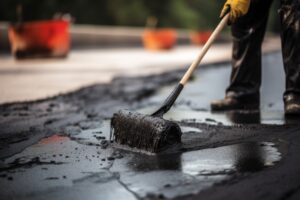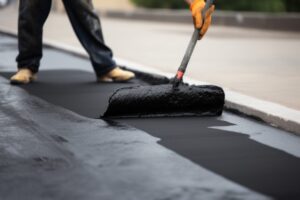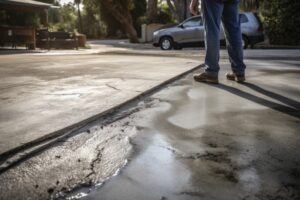The Importance of Sealcoating in Hamburg for Pavement Protection
One of the crucial steps in maintaining the longevity and integrity of your pavement is sealcoating. Sealcoating in Hamburg provides a protective layer to the asphalt surface, shielding it from the damaging effects of various environmental factors. It acts as a barrier against harsh weather conditions, including rain, sun exposure, and extreme temperatures.
By applying Sealcoating in Hamburg regularly, you can significantly prolong the lifespan of your pavement. It helps prevent cracks, potholes, and other forms of deterioration that can lead to costly repairs or even complete resurfacing. Without sealcoating, the asphalt surface becomes susceptible to oxidation, water penetration, and UV damage, causing it to weaken and deteriorate at a much faster rate. Therefore, sealcoating is not just an enhancement to the appearance of your pavement but an investment in its long-term protection.
Understanding the Effects of Weather on Asphalt Surfaces
Asphalt surfaces are constantly exposed to the elements, and weather conditions can have a significant impact on their overall condition. The effects of weather on asphalt surfaces can vary depending on the geographic location and climate.
Extreme heat can cause the asphalt to soften and become more susceptible to damage. This can lead to the formation of cracks, potholes, and other signs of deterioration. Similarly, cold temperatures can cause the asphalt to become more rigid and prone to cracking. Additionally, freezing and thawing cycles can further exacerbate these issues. The constant expansion and contraction of the asphalt can weaken its structural integrity over time. Hence, it is crucial to understand the effects of weather on asphalt surfaces in order to effectively protect and maintain them.
Common Signs of Asphalt Deterioration and Damage
Cracks, potholes, and raveling are some common signs of asphalt deterioration and damage. Cracks can appear as either hairline or larger, wider fissures. They often occur due to the natural aging process of asphalt, as well as the freeze-thaw cycles that take place during colder months. When left unattended, these cracks can expand further and lead to more extensive damage. Potholes, on the other hand, are caused by the weakening of the asphalt surface, typically due to water infiltration combined with heavy traffic. They can be a major safety concern, posing risks to both vehicles and pedestrians. Lastly, Sealcoating in Hamburg raveling refers to the gradual breaking apart of the asphalt surface, resulting in loose gravel and a rough, deteriorated appearance. It is usually caused by a combination of age, traffic, and the effects of weather conditions. Overall, these visible signs of deterioration and damage serve as indicators that prompt attention and maintenance is needed to prevent further degradation and costly repairs.
Different Types of Sealcoating Materials and their Benefits
When it comes to Sealcoating in Hamburg, there are various types of materials that can be used to provide pavement protection. One commonly used material is coal tar-based sealcoat. This type of sealcoat is known for its durability and resistance to chemicals, UV rays, and water. Additionally, coal tar-based sealcoat has a smooth and dark appearance, providing an aesthetically pleasing finish to the pavement.
Another popular Sealcoating in Hamburg material is asphalt-based sealcoat. This type of sealcoat is made from refined asphalt emulsion, which helps to restore the pavement’s original black color and provide protection against oxidation, weathering, and minor damages. Asphalt-based sealcoat is also environmentally friendly, as it does not contain coal tar and releases fewer volatile organic compounds.
Overall, choosing the right sealcoating material depends on individual preferences and specific pavement needs. Both coal tar-based and asphalt-based sealcoats have their own set of benefits, and it is important to consider factors such as durability, appearance, and environmental impact when making a decision. Regardless of the material chosen, sealcoating plays a crucial role in extending the lifespan of pavement and preserving its overall quality.
The Process of Sealcoating in Hamburg: Preparation and Application
Preparation is key when it comes to Sealcoating in Hamburg your pavement. Before applying the sealcoat, the surface needs to be thoroughly cleaned and free from any dirt, debris, oil, or loose particles. This can be done by sweeping the area and using a power blower to remove any remaining loose materials. It is essential to repair any cracks or potholes prior to sealcoating to ensure a smooth and even application. These repairs can be done using specialized asphalt patching materials.
Once the surface is clean and repaired, the sealcoat can be applied. It is recommended to use a squeegee or spray system for application, depending on the size of the area being sealcoated. The sealcoat material should be mixed according to the manufacturer’s instructions and applied in thin, even coats. It is crucial to avoid over-applying the sealcoat, as this can lead to cracking and peeling. The sealcoat should be allowed to dry thoroughly before allowing any traffic on the surface. This process typically takes about 24 to 48 hours, depending on the weather conditions.
Factors to Consider Before Sealcoating Your Pavement
When considering Sealcoating in Hamburg your pavement, there are several factors that you should take into account. Firstly, you need to assess the current condition of your pavement. Sealcoating is most effective when applied to surfaces that are in relatively good condition, without significant
cracks or damage. If your pavement is already in poor condition, it may be necessary to repair or patch any existing damage before applying a sealcoat.
Another factor to consider is the weather conditions. Ideally, Sealcoating in Hamburg
should be done during a period of dry weather, with temperatures above 50°F (10°C). This allows the sealcoat to cure properly and provide optimal protection to your pavement. Additionally, you should avoid sealcoating during periods of extreme heat or cold, as these conditions can affect the quality of the sealcoat and its ability to adhere to the pavement surface. Taking these factors into consideration will ensure that you achieve the best results when sealcoating your pavement.
Proper Maintenance Techniques to Prolong the Life of Sealcoating
To ensure the longevity of your sealcoating and maximize its effectiveness in protecting your pavement, proper maintenance techniques are essential. Regular inspections are a crucial part of maintenance, as they allow you to identify any signs of damage or deterioration early on. By promptly addressing these issues, you can prevent further deterioration and extend the life of your sealcoating.
In addition to inspections, regular cleaning is also important. Sweeping away debris and removing any stains or spills helps to maintain the integrity of the sealcoating. This prevents the accumulation of harmful substances that can cause damage over time. Moreover, keeping the surface clean also enhances its overall appearance. It is recommended to use a mild detergent and a soft-bristle brush or broom for cleaning, as harsh chemicals or abrasive tools can damage the sealcoating. By adopting these maintenance techniques, you can ensure the long-lasting protection of your pavement and save on costly repairs in the future.
Professional Sealcoating Services vs. DIY Approaches: Pros and Cons
Professional sealcoating services and DIY approaches both have their own pros and cons. One advantage of hiring professional Sealcoating in Hamburg services is the expertise and experience they bring to the table. Professionals have the knowledge and skills to assess the condition of your pavement accurately and determine the best sealcoating materials and techniques to use. They also have access to high-quality materials and equipment that may not be readily available to the average consumer. Additionally, hiring professionals can save you time and effort as they will handle all aspects of the Sealcoating in Hamburg process, from preparation to application.
On the other hand, opting for a DIY approach can be a more cost-effective option for those on a tight budget. By choosing to do it yourself, you can avoid the expenses associated with hiring professional services. DIY Sealcoating in Hamburg kits and materials are widely available in the market, making it convenient for homeowners to tackle the project on their own. Moreover, some people enjoy taking a hands-on approach to home maintenance and find satisfaction in completing the work themselves. However, it is important to note that DIY sealcoating requires a certain level of skill and knowledge. Improper application may result in subpar results or even exacerbate existing pavement issues. Therefore, it is crucial to thoroughly research and understand the process before attempting it yourself.
What is Sealcoating in Hamburg?
Sealcoating in Hamburg is a protective layer applied to asphalt surfaces to shield them from damage caused by weather, UV rays, chemicals, and normal wear and tear.
Why is sealcoating important for pavement protection?
Sealcoating in Hamburg acts as a barrier against elements like water, oil spills, and UV rays, preventing them from deteriorating the asphalt surface and extending its lifespan.
What are the effects of weather on asphalt surfaces?
Weather conditions such as rain, snow, and extreme temperatures can cause asphalt to crack, fade, and deteriorate over time if not properly protected.
How can I identify signs of asphalt deterioration and damage?
Common signs include cracks, potholes, fading color, rough texture, and the presence of oil stains. These indicate that your asphalt surface is in need of repair and Sealcoating in Hamburg.
What are the different types of sealcoating materials and their benefits?
The most common types of Sealcoating in Hamburg materials are coal tar-based and asphalt-based. Coal tar provides excellent protection against chemicals and UV rays, while asphalt-based materials offer durability and flexibility.
What is the process of sealcoating?
The process involves thorough cleaning of the surface, filling cracks and potholes, applying a primer if necessary, and then applying the sealcoat using spray equipment or brushes.
What factors should I consider before sealcoating my pavement?
Factors to consider include the age and condition of the pavement, weather conditions during application, proper preparation, and the best time of year to perform Sealcoating in Hamburg.
Can I sealcoat my pavement myself?
Yes, you can choose to do it yourself. However, professional sealcoating services have the expertise, equipment, and high-quality materials that can provide better and longer-lasting results.
What are the pros of hiring professional sealcoating services?
Professional sealcoating services offer experienced technicians, use commercial-grade materials, provide proper surface preparation, and ensure a more even and durable application.
What are the cons of DIY sealcoating?
DIY sealcoating may lack proper surface preparation, leading to poor adhesion and shorter lifespan. It can also be time-consuming, require specialized equipment, and the quality of materials may not match professional-grade products.
How can I maintain the sealcoating to prolong its life?
Regular maintenance includes keeping the surface clean, promptly repairing any cracks or potholes, avoiding harsh chemicals or deicers, and scheduling periodic inspections by professionals for touch-ups or reapplication.


